Bài số 19: Biểu tượng trong Đạo Phật – Symbols in Buddhism – Song ngữ
English: Jing Yin Ken Hudson.
Việt ngữ: Hoàng Phước Đại – Pháp danh: Đồng An.
Compile: Lotus group.

Bài số 19: Biểu tượng trong Đạo Phật – Symbols in Buddhism
When visiting a monastery, the five main objects that can be found there are Lotus Flowers, Dharma Wheels, Buddhist Flags, Bodhi Tree and a Stupa. In addition, the images of the Buddha are the most popular objects in a monastery. Each of these bears a special meaning in Buddhism.
Khi đến thăm tu viện, năm biểu tượng Đạo Phật có thể được nhận thấy đó là Hoa sen, Bánh xe Pháp, cờ Phật giáo, cây Bồ Đề và tháp chứa hài cốt của tăng đã thị tịch. Thêm vào đó, hình ảnh của Đức Phật là hình ảnh phổ biến nhất trong tu viện. Mỗi biểu tượng mang một ý nghĩa đặc biệt trong Đạo Phật.
- Lotus Flower – Hoa sen
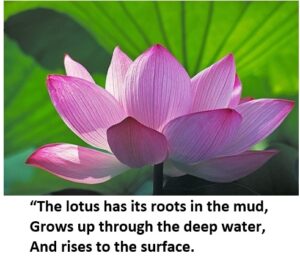
It blooms into perfect beauty and purity in the sunlight.”
The lotus flower represents purity because it is not dirtied by the filth of the mud in which it grows. Those who follow the Buddha’s teachings aim to be like the lotus. They hope to remain pure in a world of impure temptations.
“Hoa sen có rễ trong bùn
Và đâm sâu trong nước,
Cành lá vươn lên trên mặt nước.
Nó nở đẹp tinh khiết và trong sáng.
Hoa sen tượng trưng cho sự tinh khiết bởi vì nó không bị dơ bẩn bởi bùn lầy. Những người theo lời dạy của Đức Phật sống như hoa sen. Họ hy vọng giữ được tinh khiết trong thể giới đầy cám dỗ uế tạp.
2. The Dharma Wheel – Bánh xe Pháp.
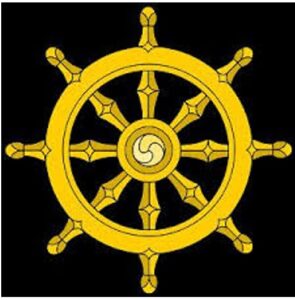
Once we start driving the car, the wheels of the car will keep rolling until it reaches the destination. Ever since the Buddha first started teaching Dharma, the Truth has spread continuously and all over the world. This will continue until all beings are freed from their suffering. The Dharma Wheel is a symbol of the continuous spreading of the Buddha’s teachings to help people live more happily.
Khi chúng ta đi xe, bánh xe được giữ để lăn mãi đến khi ta đi đến đích. Từ khi khi Đức Phật bắt đầu truyền bá Pháp, chân lý được lan rộng và lan ra khắp thế giới. Pháp được truyền bá cho đến khi tất cả chúng sanh thoát khỏi những đau khổ của họ. Bánh xe Pháp nó là biểu tượng của sự tiếp tục mãi mãi lan truyền lời dạy của Đạo Phật để giúp mọi người sống hạnh phúc hơn.
3. Buddhist Flag – Cờ Đạo Phật
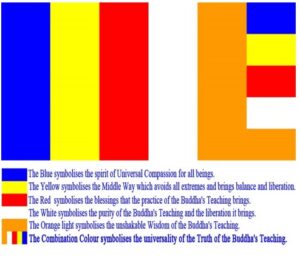
According to Buddhist records, as the Buddha sat under the Bodhi Tree, six rays of light emitted from his body after his Enlightenment. Based on this, the Buddhist flag indicates that all the different races in the world can live happily under the shield of the Buddha’s wisdom. The sixth color is the combination of blue, yellow, red, white and orange.
Theo sự ghi chép từ Đạo Phật, lúc Đức Phật giác ngộ dưới cây Bồ Đề, sáu luồng hào quang rực rỡ phát ra từ thân thể của ngài. Dựa trên điều này, cờ Đạo Phật, gồm tất cả các sắc tộc khác nhau trên thể giới sống hạnh phúc dưới sự bảo bọc thương yêu của Đức Phật.
4. Bodhi Tree – Cây Bồ Đề
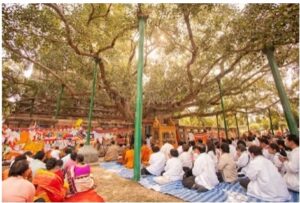
The Bodhi Tree is a Pippala tree, a kind of fig tree found in India. It became known as the Bodhi Tree after the Buddha had attained Enlightenment underneath it. Today, it is used to represent the wisdom of the Buddha. It is therefore called the Tree of Wisdom, and is respected all over the world by Buddhists. To honor the Bodhi Tree is a way of showing gratitude for the wisdom realized by the Buddha.
Cây Bồ Đề là cây Bát Tát La, thuộc loại cây sung sống ở Ấn Độ. Nó được biết đến với tên gọi cây Bồ Đề sau khi Đức Phật đạt được giác ngộ dưới bóng mát của nó. Vì vậy nó đuợc gọi là cây giác ngộ của Đức Phật và được Phật tử khắp thế giới ngưỡng mộ. Ghi nhận công lao cây Bồ Đề như là cây che chở cho Đức Phật trong quá trình tìm kiếm sự giác ngộ.
5. Stupa – Tháp
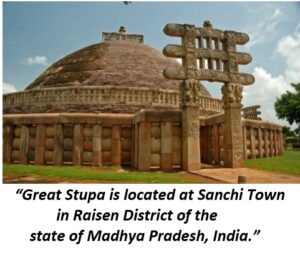
A stupa is a monument where the sacred remains of the Buddha or noble monks are kept so that people can pay their respect to them. Today, a stupa serves as a symbol for Buddhists to recall the good conduct of the Buddha and noble monks.
Tháp là nơi giữ gìn Xá lợi thiên liêng của Đức Phật hoặc của các cao tăng để mọi người chiêm ngưỡng. Ngày nay, tháp được coi như là biểu tượng của Đạo Phật để nhớ lại những phẩm chất tốt đẹp của Phật và cao tăng.
6. Buddhist Shrines and Images
Điện thờ và Thánh tượng của Đạo Phật
People often feel the need to remember the things they love and respect in a form that they can see. For instance, a photograph is kept in order to remember a loved one. The national flag is a reminder of the loyalty people feel towards their country.
The photograph and national flag are examples of symbols in remembrance of the qualities of the people or things that are being represented. They form the focal point of one’s feelings of love, respect and loyalty.
In the same way, the shrine found in Buddhist homes or monasteries is a focal point of Buddhist observances. At the center of the shrine, there is usually an image of the Buddha. This image may be made of a variety of materials such as marble, gold, wood or clay. The image is a symbol that helps people to remember the qualities of the Buddha.
The shrine may also have such objects as a volume of Buddhist scripture to represent the Dharma. Some shrines may display other items such as images, pictures or photographs of Buddhist monks and masters to represent the Sangha. When Buddhists stand before a shrine, the objects they see on it help to remind them of the qualities that are found in the Buddha and the Sangha. This inspires them to work towards cultivating these qualities in themselves.
Con người có nhu cầu nhìn lại những điều họ yêu quý và ngưỡng mộ. Chẳng hạn, một bức ảnh được lưu giữ với mục đích nhớ lại một người yêu quý. Cờ quốc gia là biểu tượng nhắc nhở sự trung thành của con người hướng về tổ quốc.
Một bức ảnh, một lá cờ quốc gia là một ví dụ của biểu tượng nhớ lại những phẩm chất của con người hoặc những gì mà nó đại diện, Chúng được tạo ra với mục đích giữ gìn cảm giác yêu thương, ngưỡng mộ và trung thành.
Với mục đích như vậy, lăng được nhìn thấy trong chùa hoặc tu viện, là nơi có đông phật tử viếng thăm. Tại trung tâm của lăng mộ, thường có hình ảnh của Đức Phật. Hình ảnh này có thể làm bằng những vật liệu đa dạng như đá hoa, vàng, gỗ hoặc đất sét. Hình ảnh này có thể là biểu tượng giúp cho mọi người nhờ lại đức hạnh của Đức Phật
Biểu tượng thiêng liêng khác là kinh Phật đại diện cho Pháp. Vài biểu tượng thể hiện dưới các hình thức khác như tranh và ảnh chụp các tỳ kheo và đại đức đại diện cho Tăng đoàn
Khi Phật tử đứng trước biểu tượng, vật thể, có thể giúp họ nhớ lại đức hạnh của Đức Phật và Tăng. Điều này thôi thúc họ cố gắng tu hành và thực tập trau dồi đức hạnh cho bản thân họ.

The reclining statue of Buddha inside Parinirvana Temple, representing the dying Buddha.
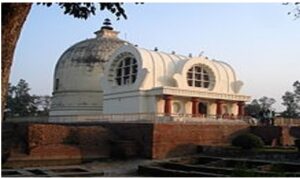
Parinirvana Stupa is a Buddhist temple in Kushinagar, India
Inside this temple, there is Reclinging Buddha image lying on its right side with the head to the north.
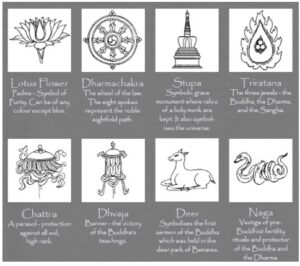
Sources:
Tài liệu tham khảo:
